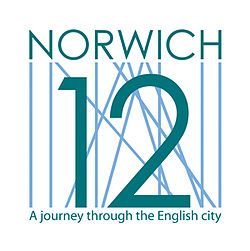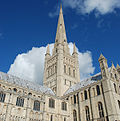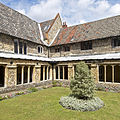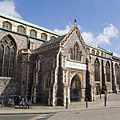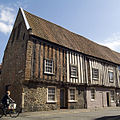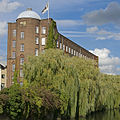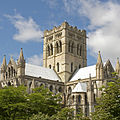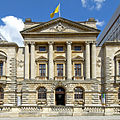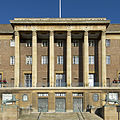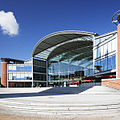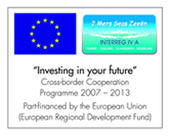- Norwich 12
-
Coordinates: 52°37′44.4936″N 1°17′32.5854″E / 52.629026°N 1.292384833°E
Norwich 12 is an initiative by Norwich Heritage Economic and Regeneration Trust (HEART) to develop 12 of Norwich's most iconic buildings into an integrated family of heritage attractions which act as an internationally important showcase of English urban and cultural development over the last 1,000 years.
Norwich HEART initially secured £1 million from HM Treasury's Invest to Save Budget to run this pioneering heritage concept.[1]
The 12 buildings are the finest collection of individually outstanding buildings from the Norman, medieval, Georgian, Victorian and modern eras.[2]
The Norwich 12 Buildings
Norwich Castle (1067-1075)
-
- Norwich Castle was built as a royal palace for William the Conqueror at a time when most buildings were small, wooden structures. The huge stone keep was a symbol of the king's power.
-
- The Castle mound (motte) is the largest in the country, and from the 14th to 19th century the keep was used as a county gaol.
Norwich Cathedral (1096-1145)
- An iconic Norman cathedral and one of the most complete Romanesque buildings in Europe.
-
- Most of Norwich Cathedral's Norman architecture is still intact and it forms one of the finest examples of the Romanesque style in Europe. Like the Castle, the Cathedral's awe-inspiring scale signified the power and permanence of the Norman invaders.
-
- Caen stone was transported from Normandy and the immense building project required an army of masons, craftsmen, glaziers and laborers. Some of the original Norman wall painting survives in the Cathedral's Jesus Chapel and the presbytery.
-
- Norwich Cathedral has the highest Norman tower (40 metres) and largest monastic cloisters in England, as well as a unique and world-renowned collection of medieval roof carvings.
The Great Hospital (1249)
- An exceptional set of medieval hospital buildings, in continuous use for more than 750 years.
-
- Norwich's Great Hospital has been in continuous use as a caring institution since it was founded for the care of poor chaplains in the 13th century. The six acre complex of buildings and extensive archives provide a unique living history of the last 750 years.
-
- The site includes the ancient parish church of St Helen and Eagle Ward with its lavishly decorated 'eagle ceiling', originally the chancel of the church. There is also a refectory, cloisters, 15th and 16th century wings, 19th century almshouses, the Birkbeck Hall, a fine example of Victorian/Edwardian Gothic revival architecture, and St Helen's House, built by Thomas Ivory in the 18th century.
The Halls - St Andrew's and Blackfriars' (1307-1470)
- The most complete medieval friary complex surviving in England.
-
- St Andrew's Hall is the centrepiece of several magnificent flint buildings, known as The Halls, which form the most complete friary complex surviving in England. The first Dominican Black Friars' priory was destroyed by fire and St Andrew's Hall formed the nave of the new church, completed in 1449.
-
- During the Reformation, the site was saved by the City Corporation, which bought it from the king for use as a 'common hall.' Since then the complex has been used for worship, as a mint and as a workhouse.
The Guildhall (1407-1424)
- England's largest and most elaborate provincial medieval city hall
-
- The elaborate design and size of the Guildhall reflect Norwich's status as one of the wealthiest provincial cities in England in medieval times.
-
- The building represents the growing economic and political power of the new ruling elite that was emerging - wealthy freemen who were merchants and traders.
-
- Norwich was given more self-governing powers in 1404 and the Guildhall was built to house the various civic assemblies, councils and courts that regulated its citizens' lives.
Dragon Hall (1427-1430)
- A magnificent medieval merchant's trading hall, unique in Europe.
-
- Dragon Hall is a medieval trading hall, built by Robert Toppes, a wealthy local merchant, for his business. The first floor of the 27 metre timber-framed hall has an outstanding crown post roof with a beautifully carved dragon, which gives the building its name.
-
- After Toppes' death, the building was converted for domestic use and then, in the 19th century, subdivided into shops, a pub and tenements. The great crown post roof was hidden from view for many years and only rediscovered in the 1980s.
The Assembly House (1754-1755)
- One of the most glorious examples of Georgian assembly rooms architecture in the country.
-
- When it opened, the Assembly House was used as a centre for entertainment and assemblies for the local gentry. During its long history it has hosted a waxworks exhibition by Madame Tussaud, a concert by the composer Franz Liszt, and many lavish balls.
St James Mill (1836-1839)
- The quintessential English Industrial Revolution mill
-
- St James Mill is the archetypal English Industrial Revolution mill in perhaps an unexpected part of the UK. It was built on a site occupied by the White Friars (Carmelites) in the 13th century, and an original arch and undercroft survive.
-
- When the local textile trade went into decline, St James Mill was bought by Jarrold & Sons Ltd for use by its printing department in 1902. The building was subsequently leased to Caley's, the chocolate manufacturer, and sold to the government as a training factory for war veterans in 1920.
The Cathedral of St John the Baptist (1884-1910)
- One of the finest examples of Victorian Gothic architecture in England.
-
- The Cathedral of St John the Baptist is a particularly fine example of 19th-century Gothic revival architecture. By the 19th century Catholics were once again free to worship in public and the Cathedral was a gift to the city by Henry Fitzalan Howard, 15th Duke of Norfolk, as part of his personal mission to bring Catholicism into the centre of English life.
-
- Designed in the Early English style by George Gilbert Scott Junior, St John's contains some of the finest 19th-century stained glass in Europe. It also has a wealth of Frosterley marble and exquisite stone carving.
Surrey House (1900-1912)
- One of the most elegant and opulent Edwardian office buildings in Britain.
-
- Surrey House, the historic home of Aviva (formerly Norwich Union), is a spectacular piece of Edwardian architecture designed by George Skipper. He was commissioned by The Norwich Union Life Insurance Society's directors to produce a 'splendid yet functional office space', incorporating Greek influences and the themes of insurance, protection and wellbeing, to reassure policyholders of the company's strength and prosperity.
City Hall (1936-1938)
- One of the finest municipal buildings of the inter-war period in England
-
- Norwich City Hall was built when the Guildhall and existing municipal offices could no longer accommodate the growth in local government duties in the 20th century.
-
- The city council consulted the Royal Institute of British Architects (RIBA) and organized an architectural competition to design a new municipal building. The winning design was made from solid brick walls, reflecting the council's belief that a civic building of such importance deserved solid foundations.
The Forum (1999-2001)
- The landmark Millennium building for the East of England and a stunning example of 21st-century design.
-
- The Forum was funded by the Millennium Commission with matching support from Norfolk County Council, Norwich City Council and the business community.
-
- A striking example of post-war architecture, the building houses the Norfolk & Norwich Millennium Library and 2nd Air Division Memorial Library, Norwich Tourist Information Centre, a cafe and PizzaExpress restaurant and is home to BBC East's headquarters.
-
- In 2009 it opened a series of innovative community facilities, including Fusion, Europe's largest permanent digital gallery with free public access and a state-of-the-art auditorium. Different every day, The Forum also hosts a year-round line-up of free and ticketed events, exhibitions and entertainment.[3][4]
Exploring the 12
While not all of the Norwich 12 attractions are open to the public, a main focus of the project has been to improve accessibility to each of the sites.
All 12 can be explored by means of guided walks and tours, exhibitions and music/performances at the venues, or via heritage interpretation leaflets, signage, websites and guide books.
Norwich 12 tours
- Tours between and around the 12 buildings run from July to September. In 2010 there were 4 tours, with each lasting approximately 3 hours.[5]
Norwich 12 guidebook, film & postcards
- A Norwich 12 Guidebook,[6] film[7] and postcard set have been produced in order to give the public an insight into the histories of the buildings. The postcard pack features the winning images from Norwich HEART's first annual photography competition in 2008/9.[8]
Norwich 12 totems
- Heritage interpretation totems have been installed beside each of the 12 buildings. These detail the key names and dates associated with the buildings and also contain bluetooth technology capable of delivering additional heritage information to mobile phones.[9]
SHAPING 24
SHAPING 24 - Strategies for Heritage Access Pathways in Norwich and Ghent - is a new tourism initiative, also coordinated by Norwich HEART, that links together the Norwich 12 buildings, with 12 heritage sites in Ghent in Belgium.
The project seeks to increase awareness of the longstanding historical links between the East of England and the Low Countries.
The SHAPING 24 project is part-funded by the European Regional Development Fund from the European Union's INTERREG IVA 2 Mers Seas Zeeen Cross-border Cooperation Programme 2007-2013.[10]
Gent: 12 x erfgoed
The 12 heritage sites in Ghent are:[11]
- St Bavo's Abbey
- St Peter's Abbey
- St Bavo's Cathedral
- Castle of the Counts
- St Nicolas' Church
- Beguinages
- Lange Voilettestraat
- Sint-Amandsberg
- Bijloke Monastery Site
- The Belfry
- Ghent City Hall|City Hall
- Hotels
- Hotel Clemmen
- Hotel d'Hane-Steenhuyse
- Museum of Fine Arts
- Book Tower
References
- ^ http://www.norwich12.co.uk/about-us/about-the-norwich-12-project.htm
- ^ http://www.norwich12.co.uk/
- ^ a b c d e f g h i j k l Norwich 12 Leaflet, Norwich HEART, 2010
- ^ a b c d e f g h i j k l Norwich 12 Guidebook, Norwich HEART, 2008. ISBN 978-0-9560385-0-0
- ^ http://www.norwich12.co.uk/getting-around/norwich-12-tours.htm
- ^ http://www.norwich12.co.uk/projects/norwich-12-guidebook.htm
- ^ http://www.norwich12.co.uk/projects/norwich-12-films.htm
- ^ http://www.norwich12.co.uk/projects/photography-competition.htm
- ^ http://www.heritagecity.org/news.php?newsId=89
- ^ http://www.shaping24.eu/
- ^ http://www.shaping24.eu/en/ghent/buildings
External links
Categories: -
Wikimedia Foundation. 2010.

